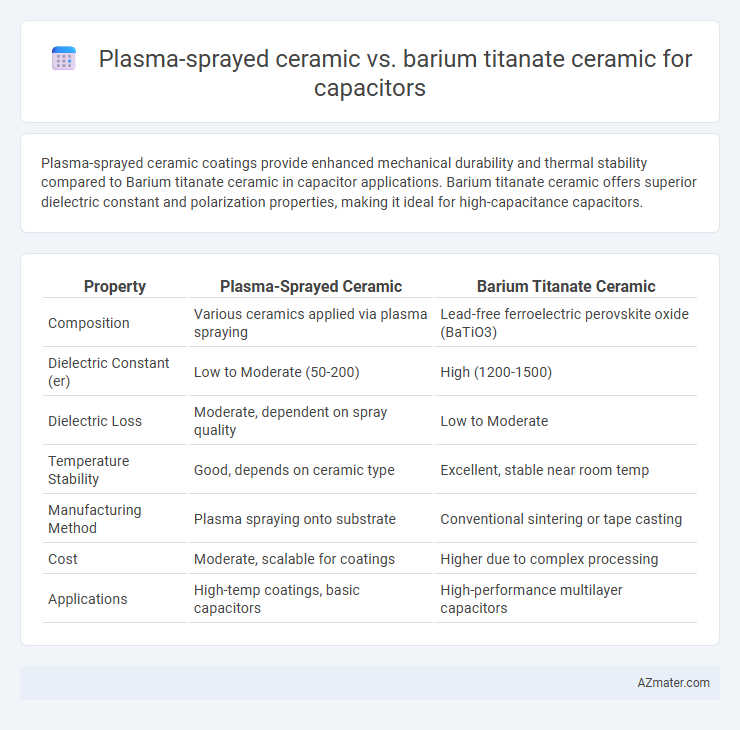Plasma-sprayed ceramic coatings provide enhanced mechanical durability and thermal stability compared to Barium titanate ceramic in capacitor applications. Barium titanate ceramic offers superior dielectric constant and polarization properties, making it ideal for high-capacitance capacitors.
Table of Comparison
| Property | Plasma-Sprayed Ceramic | Barium Titanate Ceramic |
|---|---|---|
| Composition | Various ceramics applied via plasma spraying | Lead-free ferroelectric perovskite oxide (BaTiO3) |
| Dielectric Constant (er) | Low to Moderate (50-200) | High (1200-1500) |
| Dielectric Loss | Moderate, dependent on spray quality | Low to Moderate |
| Temperature Stability | Good, depends on ceramic type | Excellent, stable near room temp |
| Manufacturing Method | Plasma spraying onto substrate | Conventional sintering or tape casting |
| Cost | Moderate, scalable for coatings | Higher due to complex processing |
| Applications | High-temp coatings, basic capacitors | High-performance multilayer capacitors |
Introduction to Ceramic Capacitors
Ceramic capacitors utilize dielectric materials like plasma-sprayed ceramics and barium titanate ceramics, each offering distinct electrical properties. Plasma-sprayed ceramic coatings provide enhanced mechanical strength and thermal stability, making them suitable for high-temperature applications. Barium titanate ceramics exhibit high dielectric constants and excellent permittivity, essential for achieving greater capacitance in compact capacitor designs.
Overview of Plasma-Sprayed Ceramic Materials
Plasma-sprayed ceramic materials offer enhanced thermal stability and mechanical strength, making them ideal for capacitor dielectrics requiring high temperature resistance. This technique enables the deposition of dense, uniform ceramic coatings such as alumina or zirconia, which exhibit superior insulation properties compared to conventional barium titanate ceramics. While barium titanate ceramics provide excellent dielectric constants and ferroelectric properties, plasma-sprayed ceramics facilitate improved mechanical durability and long-term reliability in harsh operating conditions.
Properties of Barium Titanate Ceramics
Barium titanate ceramics exhibit high dielectric constant, excellent ferroelectric properties, and strong temperature stability, making them ideal for capacitor applications. They offer superior permittivity and low dielectric loss compared to plasma-sprayed ceramics, which typically have lower density and may contain structural defects affecting performance. The intrinsic piezoelectric and pyroelectric properties of barium titanate further enhance its functionality in high-performance multilayer capacitors.
Fabrication Methods: Plasma Spraying vs Conventional Sintering
Plasma-sprayed ceramic capacitors utilize a high-temperature, rapid deposition process that creates dense, uniform ceramic coatings with excellent adhesion, enabling tailored microstructures and reduced fabrication times compared to conventional sintering. Barium titanate ceramics are typically fabricated via conventional sintering, involving powder compaction and high-temperature heat treatment that promotes grain growth and densification, but requires longer processing times and careful temperature control to achieve optimal dielectric properties. The plasma spraying method offers superior control over coating thickness and microstructure, while conventional sintering ensures high dielectric constant and stability essential for Barium titanate capacitor performance.
Dielectric Performance Comparison
Plasma-sprayed ceramic coatings exhibit lower dielectric constants and higher dielectric losses compared to barium titanate ceramics, limiting their efficiency in high-performance capacitor applications. Barium titanate ceramics offer a high dielectric constant usually ranging from 1000 to 6000, enabling superior energy storage and enhanced capacitance. The intrinsic ferroelectric properties of barium titanate provide stable dielectric permittivity and reduced leakage currents, resulting in improved overall dielectric performance over plasma-sprayed ceramics.
Mechanical and Thermal Stability
Plasma-sprayed ceramics exhibit superior mechanical stability due to their dense microstructure and strong adhesion to substrates, making them resistant to cracking and mechanical wear in capacitors. Barium titanate ceramics provide excellent thermal stability with a high dielectric constant that remains stable across a wide temperature range, essential for maintaining capacitor performance during thermal cycling. While plasma-sprayed ceramics offer enhanced mechanical durability, barium titanate excels in achieving consistent thermal and dielectric properties crucial for high-performance capacitor applications.
Microstructural Differences
Plasma-sprayed ceramic capacitors exhibit a porous and heterogeneous microstructure due to rapid solidification and particle melting, resulting in varied grain sizes and potential microcracks that influence dielectric performance. In contrast, Barium titanate ceramics synthesized via conventional sintering present a dense, uniform microstructure with well-defined grain boundaries and high crystallinity, which enhances dielectric constant and reduces loss. The microstructural differences between these materials directly impact their electrical properties, reliability, and suitability for high-performance capacitor applications.
Cost and Scalability Considerations
Plasma-sprayed ceramic coatings typically offer lower manufacturing costs and enhanced scalability due to their compatibility with high-throughput industrial processes, making them suitable for large-scale capacitor production. Barium titanate ceramics, while providing superior dielectric properties, involve more complex synthesis and sintering steps that increase cost and limit scalability. Cost efficiency and mass production potential favor plasma-sprayed ceramics, whereas barium titanate remains preferable for high-performance, smaller-scale applications.
Applications in Advanced Capacitor Design
Plasma-sprayed ceramics offer enhanced dielectric strength and thermal stability, making them ideal for high-temperature and high-frequency capacitor applications. Barium titanate ceramic exhibits superior permittivity and tunable dielectric properties, crucial for multilayer ceramic capacitors (MLCCs) used in precision electronics and energy storage. Integrating plasma-sprayed ceramic coatings with barium titanate substrates advances capacitor design by improving mechanical durability while maintaining high dielectric performance.
Future Prospects and Research Directions
Plasma-sprayed ceramic coatings offer enhanced dielectric strength and thermal stability, making them a promising candidate for next-generation capacitors requiring high power density and reliability. Barium titanate ceramic remains a cornerstone material due to its high dielectric constant and tunable ferroelectric properties, with ongoing research focusing on doping techniques and grain boundary engineering to optimize performance. Future research is expected to explore hybrid structures combining plasma-sprayed layers with barium titanate to leverage synergistic effects, advancing capacitor miniaturization and energy storage efficiency.

Infographic: Plasma-sprayed ceramic vs Barium titanate ceramic for Capacitor
 azmater.com
azmater.com